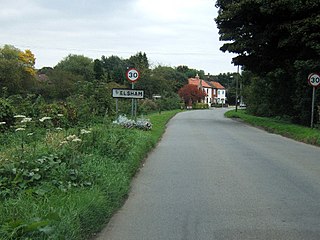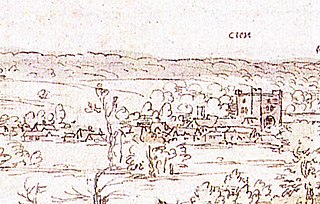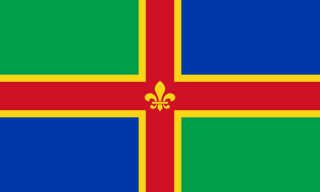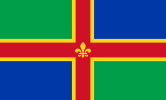
Alkborough is a parish of 458 people in 192 households in North Lincolnshire, England, located near the northern end of The Cliff range of hills overlooking Trent Falls, the confluence of the River Trent and the River Ouse.

Elsham is a village and civil parish in North Lincolnshire, England. The population of the civil parish at the 2011 census was 400. It is situated 4 miles (6 km) north from Brigg, 1 mile (1.6 km) north from the M180 and 1 mile (1.6 km) west from the A15 road.
Axholme Charterhouse or Axholme Priory, also Melwood Priory or Low Melwood Priory, North Lincolnshire, is one of the ten medieval Carthusian houses (charterhouses) in England. It was established in 1397/1398 by Thomas Mowbray, Earl of Nottingham and later Duke of Norfolk. The house was centred on a pre-existing chapel on the present Low Melwood Farm, between Owston Ferry and Epworth in the Isle of Axholme, which according to a papal bull of 1398 "was called anciently the Priory of the Wood".

Elsham railway station is a former railway station in Elsham, Lincolnshire, England. The station was opened by the Trent, Ancholme and Grimsby Railway on 1 October 1866 and like other T. A. & G. stations had staggered platforms. The station was the most easterly of the T. A. & G. stations the line, situated just a few miles from Wrawby Junction, Barnetby where it joined the M. S. & L. R. towards Grimsby. It was formally closed by British Rail on 3 October 1993.

Exeter monastery is a collection of diverse and in many cases unrelated monastic establishments that existed at various times during the Middle Ages in the city of Exeter, Devon, England. The monastic buildings included:
Nunburnholme Priory was a priory of Benedictine nuns in the East Riding of Yorkshire, England. It was founded during the reign of Henry II of England by an ancestor of Robert de Merlay, lord of Morpeth. Except for its demesne, it possessed only little property in its surroundings. In 1313 the prioress claimed the monastery of Seton in Coupland as a cell of Nunburnholme. In 1521 only five nuns and the prioress lived here, and on 11 August 1536 the house was suppressed. It was valued as the poorest and smallest of the Benedictine nunneries in Yorkshire surviving until then.

Nunkeeling Priory was a priory of Benedictine nuns in the East Riding of Yorkshire, England founded by Agnes de Arches or de Catfoss in 1152. It was dedicated to St. Mary Magdalene and to St. Helen. The priory suffered from great powerty towards the end of the 13th century. In the early 14th century several cases of disobedience among the nuns became known, leading to disciplinary measures ordered by the archbishop of York. Nunkeeling priory was mot immediately Dissolution of the Monasteries dissolved in 1536, but even refounded in 1537. However, it was finally surrendered in 1540, with the last prioress, Christine Burgh, moving to Catterick.

Watton Priory was a priory of the Gilbertine Order at Watton in the East Riding of Yorkshire, England. The double monastery was founded in 1150 by Eustace fitz John.

Burwell Priory was a priory in the village of Burwell, Lincolnshire, England.
Cammeringham Priory was a priory in Cammeringham, Lincolnshire, England.
Gokewell Priory was a Cistercian Catholic priory in Broughton, Lincolnshire, England..
Great Limber Preceptory, Limber Magna was a Camera (farm) of the Knights Templar and later the Knights Hospitaller in the village of Great Limber, Lincolnshire, England.

Kyme Priory was a priory in South Kyme, Lincolnshire, England. What remains of the buildings are now part of Saint Mary and All Saints Church.

St. Mary Magdalen was a Benedictine priory in Lincoln, England. Along with Sandtoft Priory and Hanes Cell, it was a Lincolnshire cell of St Mary's Abbey in York, England. A surviving building, once owned by the priory, is Monks' Abbey, Lincoln.
Thwaite Priory was a monastery at Welton le Marsh in Lincolnshire, England. It was a house of Augustinian Canons Regular, dependent on Thornton Abbey, founded before 1440 and thought to have been dissolved before 1536.
Drax Priory was an Augustinian priory at Drax in North Yorkshire, England, founded between 1130 and 1139 by William Paynel. The Priory has sometimes been called an abbey, though this is judged to be incorrect. Permission was given to crenellate the priory in 1362.
Embsay Priory was a medieval monastic house in North Yorkshire, England.

Sheen Priory in Sheen, now Richmond, London, was a Carthusian monastery founded in 1414 within the royal manor of Sheen, on the south bank of the Thames, upstream and approximately 9 miles southwest of the Palace of Westminster. It was built on a site approximately half a mile to the north of Sheen Palace, which itself also occupied a riverside site, that today lies between Richmond Green and the River Thames.

The Charterhouse was a Carthusian monastery and almshouse in Kingston upon Hull, England, built just outside the town's walls. The hospital building survived the Dissolution of the Monasteries; the priory was destroyed in 1538. The structure of the hospital was destroyed before the first siege of Hull during the English Civil War. A replacement was built in 1645, which was replaced again in 1780; the buildings function as an almshouse with an attached chapel, and remain in use to the present day (2012).
















